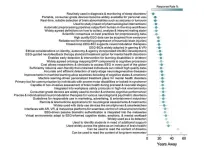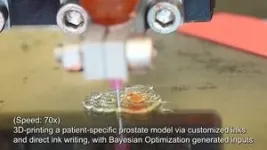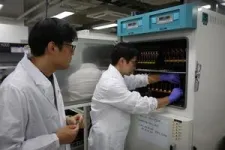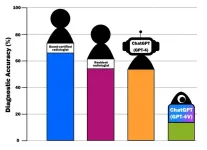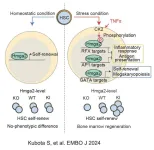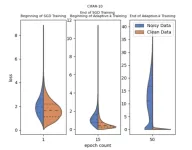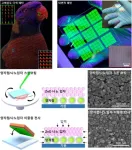(Press-News.org) One hundred years after the human brain’s electrical activity was first recorded, experts are celebrating the legacy of its discovery and sharing their predictions and priorities for its future.
Since the first recording in July 1924, human electroencephalography (EEG) has been integral to our understanding of brain function and dysfunction: most significantly in the clinical diagnosis of epilepsy, where the analysis of the EEG signal meant that a condition previously seen as a personality disorder was quickly redefined as a disorder of brain activity.
Now, a century on, more than 500 experts from around the globe, have been asked to reflect on the impact of this groundbreaking methodology, as well as on the challenges and priorities for the future.
A survey, led by University of Leeds academics, saw respondents - with 6,685 years of collective experience - presented with possible future developments for EEG, ranging from those deemed ‘critical to progress’ to the ‘highly improbable,’ and asked to estimate how long it might be before they were achieved. The results are published today (22 August 2024) in the journal Nature Human Behaviour.
Futuristic innovations
The list features an array of fascinating, futuristic innovations that experts believe could be achieved within a generation. This includes using EEG to enhance cognitive performance; early detection of learning disabilities; widespread use as a lie detector; and use as a primary communication tool for those with severe motor disabilities and locked-in syndrome.
Real-time, reliable diagnosis of brain abnormalities such as seizures or tumours is believed to be just 10-14 years away, while the probability of reading the content of dreams and long-term memories is judged to be more than 50 years away by some experts, but dismissed by many as closer to science fiction than reality.
It may be surprising to many that, according to the survey published today (22 August) in the journal Nature Human Behaviour, within a generation we could all be carrying around our own, personal, portable, EEG.
The paper’s co-author, Dominik Welke, Research Fellow at the University of Leeds, said: “They could really become something like a smartphone: where almost everybody has access to them and can use them daily - ideally improving their life by providing meaningful insight into physiological factors.”
He added: “One such positive, potential future use of EEG technology could be vigilance control for drivers or pilots. These work-safety systems could assist the user in identifying if they were falling asleep, then wake them up or tell the co-pilot they need to take over."
The hardware involved in recording EEG is relatively basic, remaining unchanged – in principle – since it was first used by psychiatrist Hans Berger, in Germany, on July 6, 1924. What has drastically changed since then is the analysis of – and what we can do with – the now digitally-recorded data.
Consisting of just electrodes and an amplifier, EEG systems are becoming increasingly cheap to produce, as well as more portable and user-friendly. Coupled with its non-invasive nature, there is little to prevent it from becoming more accessible to a wider audience.
Reducing health inequalities
While the prospect of EEG technology being widely used in gaming and VR – predicted to be only around 20 years away - will thrill gamers, the truly exciting possibility for scientists and clinicians is that this increasing accessibility will allow them to engage with communities traditionally excluded from EEG research, crucially, in low-income countries that cannot afford more complex imaging technology.
Advances in AI-driven automation are also expected to improve and speed up analysis of complicated data.
Dr Welke said: “Looking ahead to the future: from the hardware side, it’s comparatively cheap and easy to produce, and from the analysis and software side, with these new computing technologies, all the puzzle pieces are there to really roll out EEG to a very large user base.
“As opposed to other methods out there - such as MRI, or implanted devices - EEG has the potential to make neuroimaging available to all the people in the world.”
The paper’s lead author, Faisal Mushtaq, Professor of Cognitive Science and the Director of the Centre for Immersive Technologies at the University of Leeds, said: “Nearly all the data we currently have on the human brain comes from a very small segment of the world’s population.
“There is a growing recognition that this is hampering our ability to generalise findings and improve global brain health.
“EEG stands out as the most cost-effective and logistically feasible neuroimaging tool for worldwide use across diverse settings. This would help build a neuroscience that is inclusive and representative of the global population.
He added: “Our partners at the Global Brain Consortium are laying the foundations for increasing reach in this way and I expect this will unlock new opportunities for groundbreaking discoveries on the mechanisms of brain function.”
Ethical questions
Alongside the optimism that emerging technologies are opening exciting new possibilities for EEG, the experts consulted also sounded a note of caution, with concerns that ranged from a lack of adherence to agreed standards and protocols to ethical questions created by novel commercial applications and the lure of ‘neuroenhancement’.
Dr Welke said: “I'm sure some of the multi-national tech companies might be very interested in rolling out EEG or other neuroimaging technology, just to get more information on their users that hints at their preferences and emotions 24 hours a day. But should it be used in this way?
“There are obvious concerns around cognitive freedom and mental privacy. This feeds back into the importance of ‘responsibility’ – the fact that new ways of using a technology are also likely to raise new ethical questions.”
Another objective of the survey was to identify the priorities of the EEG community for guiding future efforts. Participants rated how important major developments and advancements in various domains of EEG research would be to their work.
Professor Mushtaq said: “I think that EEG, when combined with technologies such as AI and virtual reality, could radically transform the ways in which we interact with machines, and in doing so, play an extremely important role in science and society over the next 100 years.
“But to ensure this, the neuroscience community—from academic, clinical and industry settings—must commit to promoting robust, ethical, inclusive, and sustainable practices that will help realise its enormous potential.”
The work was conducted by more than 90 authors, ranging from early career researchers to eminent figures in the field, collectively known as the EEG100 consortium.
It started out as a partnership between #EEGManyLabs – an international network of researchers from more than 30 countries assessing the replicability of the results of some of the most important and influential EEG experiments of psychological phenomena - and the Global Brain Consortium, a diverse network of brain researchers, clinicians and institutions committed to achieving improved and more equitable health outcomes worldwide.
The paper’s last author, Pedro Antonio Valdés-Sosa, Director of China Cuba Laboratory for Neurotechnology at the University of Electronic Science and Technology of China/Cuban Neuroscience Center, said: “In several countries, including Cuba, we have demonstrated that EEG can mass-screen some nervous system disorders at a population level.
"This technology is especially appropriate when resources are limited, as they are in disengaged groups worldwide.
"There are hurdles to overcome to employ EEG at a global scale, but by doing so, we can hopefully improve millions more lives.”
Dr Sadhana Sharma, Head of Bioscience for Health Strategy at the Biotechnology and Biological Sciences Research Council (BBSRC) - which funded the paper’s lead authors - said: "EEG technology has the potential to transform our day-to-day activities and how we diagnose and treat neurological conditions in the future, ensuring that insights into brain health are accessible to diverse populations worldwide.
“As we embrace developments in bioscience, our focus remains on fostering interdisciplinary collaborations that drive ethical, equitable and impactful advancements in brain science on a global scale."
END
Will EEG be able to read your dreams? The future of the brain activity measure as it marks 100 years
2024-08-22
ELSE PRESS RELEASES FROM THIS DATE:
Investigating the role of interhemispheric pathways in motor recovery
2024-08-22
Stroke and spinal cord injuries can severely impair motor functions, and understanding how to promote recovery is a critical challenge. While damaged neurons in the brain and spinal cord have limited ability to regenerate, the brain can form or strengthen alternative neural pathways involving uninjured parts of the brain, enabling functional recovery. Such reorganization of pathways in the brain is called neural plasticity, and identifying the involved pathways and understanding their functions can ...
Clinical trial in Ireland challenges beliefs about Ozempic and similar new obesity treatments
2024-08-22
A study carried out in St Vincent’s University Hospital (SVUH) Dublin challenges the belief that weight loss medications such as Ozempic, Wegovy or Monjaro work just by promoting satiety and making you eat less.
The randomized controlled trial with 30 patients was led by Professor Donal O’Shea, SVUH and UCD School of Medicine, and examined the family of medications based on the hormone Glucagon-like peptide-1 (GLP-1).
The findings published today in the Journal of the Obesity Society shows that there is a strong relationship between the increase in metabolic ...
Mouse study: Proteins do the damage in fetal abdominal inflammation
2024-08-22
Inflammation of the abdominal cavity in human fetuses resulting from a perforation of their intestine is likely to be caused by proteins contained in the fetal stool. This is the result of a Kobe University study that establishes a new mouse model allowing research and drug development for a condition that is otherwise difficult to approach.
The fetus’s stool, called the “meconium,” is sterile but nevertheless causes inflammation of the abdominal cavity when it leaks out of the intestine after a perforation. Called “meconium peritonitis,” this is a life-threatening condition for the baby with a mortality rate of 10%-15% in humans, and neither a cause ...
Let me take a look: AI could boost diagnostic imaging results
2024-08-22
In radiology, diagnostic imaging requires specialized knowledge to interpret the findings associated with a wide variety of diseases. Fortunately, in recent years, generative AI models, such as Chat Generative Pre-trained Transformer (ChatGPT), have shown potential as diagnostic tools in the medical field, but their accuracy must be evaluated for optimal use in the future.
Therefore, Dr. Daisuke Horiuchi and Associate Professor Daiju Ueda of Osaka Metropolitan University’s Graduate School of Medicine led a research team that compared the diagnostic accuracy of ChatGPT and radiologists. They used 106 musculoskeletal radiology cases with patient medical history, images, ...
Prof Carl Kocher explores how you can stretch your mind to grasp quantum entanglement
2024-08-22
My new article, ‘Quantum Entanglement of Optical Photons: The First Experiment, 1964-67’, is intended to convey the spirit of a small research project that reaches into uncharted territory. The article breaks with tradition, as it offers a first-person account of the strategy and challenges for the experiment, as well as an interpretation of the final result and its significance. In this guest editorial, I will introduce the subject and also attempt to illuminate the question ‘What is a paradox?’
Let’s begin with the gyroscope that I bought when I was eight, from a store ...
Unveiling the secret of blood regeneration: New insights into stress responses in hematopoietic stem cells (HSC)
2024-08-22
Kumamoto University researchers have made a groundbreaking discovery that sheds light on how the HMGA2 gene—an essential transcriptional activator involved in chromatin modification—regulates stress responses in hematopoietic stem cells (HSCs), thereby enhancing blood cell production recovery.
Exposure to infections or treatments such as chemotherapy often leads to a rapid decline in blood cells, including red blood cells and platelets. HSCs, which reside in the bone marrow that can develop into various types of blood cells, are crucial for recovering from these stress-induced blood disorders. Under stressd ...
MCG physicians working to help prevent vision loss associated with space travel
2024-08-22
Physicians at the Medical College of Georgia at Augusta University are working with Polaris Dawn, the first of the Polaris Program’s three human spaceflight missions, to better understand the eye changes many astronauts experience during spaceflight that can leave them with a wide range of symptoms once they return to Earth — from a new need for glasses to significant loss of vision. The Polaris Program is a first-of-its-kind effort to rapidly advance human spaceflight capabilities while continuing to raise funds and awareness for important causes on Earth.
More than 70% of astronauts experience a phenomenon ...
Adaptive-k: A simple and effective method for robust training in label noisy datasets
2024-08-22
Training deep learning models on large datasets is essential for their success; however, these datasets often contain label noise, which can significantly decrease the classification performance on test datasets. To address this issue, a research team consisting of Enes Dedeoglu, H. Toprak Kesgin, and Prof. Dr. M. Fatih Amasyali from Yildiz Technical University developed a groundbreaking method called Adaptive-k, which improves the optimization process and yields better results in the presence of label noise. Their research was published on 15 August 2024 in ...
Developing innovative new display technologies! Create ultrahigh-definition screens efficiently!
2024-08-22
□ A team led by Professor Ji-woong Yang of DGIST’s (President Kun-woo Lee) Department of Energy Science and Engineering, in collaboration with Professor Moon-kee Choi of UNIST's Department of New Materials and Dr. Taeg-hwan Hyun of the IBS Nanoparticle Research Center, has developed a double-layer dry transfer printing technology that simultaneously transfers light-emitting and electron-transferring layers onto a substrate. This technology is expected to provide a more life-like view in augmented reality (AR) and virtual reality (VR), greatly enhancing the immersive experience.
□ ...
Physicist Hollen honored as Moore Foundation Experimental Physics Investigator
2024-08-22
Shawna Hollen, associate professor of physics, has been named to The Gordon and Betty Moore Foundation’s 2024 cohort of Experimental Physics Investigators. The prestigious honor, which is accompanied by $1.25 million in funding over the next five years, will advance understanding of the link between charge density waves and quantum dots, two physical phenomena that could lead to improvements in quantum computing.
“The ideas that I put forward [in my proposal] haven’t been demonstrated. It’s not something that anyone else ...
